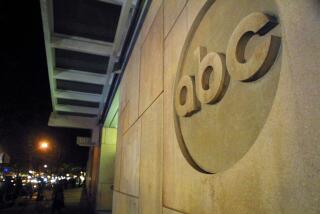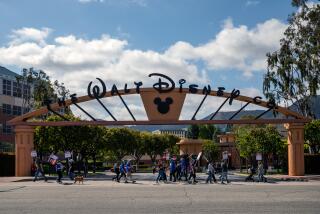Disney Pushed Toward Digital
In Walt Disney Co.’s upcoming animated tale “Brother Bear,” an American Indian boy is transformed into a 7-foot grizzly and has trouble adjusting to his new body.
Meanwhile, Disney is undergoing a radical transformation of its own, experiencing wrenching internal changes in its bedrock animation business.
For the first time in decades, the entertainment giant that pioneered feature-length animation with 1937’s “Snow White and the Seven Dwarfs” has no traditional animated big-budget movies in production.
The sea change comes as audiences and most Hollywood studios have largely shunned traditional, 2-D hand-drawn animation in favor of cartoons that feature dazzling, lifelike images generated on a computer.
“The realities are that consumer expectations are now driven by a new type of animation that has three dimensions,” said Jeffrey Logsdon, a media analyst with Harris Nesbitt Gerard.
Two costly traditional animated features released in the last year, Disney’s “Treasure Planet” and DreamWorks SKG’s “Sinbad: Legend of the Seven Seas,” bombed at the box office. By contrast came the soaring success of those studios’ respective computer-generated blockbusters “Finding Nemo,” in partnership with Pixar Animation Studios, and “Shrek,” further helping to turn the animation industry on its head.
Most of Disney’s competitors, including newcomer Sony Corp.’s Sony Pictures Entertainment, News Corp.-owned 20th Century Fox and AOL Time Warner Inc.-owned Warner Bros., are focused exclusively on producing digitally animated movies for their big-budget offerings.
Even Disney archrival DreamWorks, headed by former Disney Studios chief Jeffrey Katzenberg, who once banked heavily on costly 2-D fare, has abandoned hand-drawn animation for now. “Until audiences show some affection for 2-D, we’re not going to get back into it,” said DreamWorks spokeswoman Terry Press.
One of the rare exceptions in the march toward digital is Vivendi Universal’s Universal Pictures, which along with Imagine Entertainment plans to produce a 2-D version of the classic children’s series “Curious George.” The studio originally had planned a more expensive digital version. It opted for a lower-cost 2-D format, viewing it as a better creative fit with the original book character.
Viacom Inc.-owned Nickelodeon Movies has a couple of 2-D movies in the pipeline, but its slate is heavily dominated by computer-generated or mixed-media animation projects, including a 3-D version of “Mighty Mouse,” to be directed by live-action filmmaker John Woo.
The 3-D technique “lets us create worlds never seen before, and that’s what people look for on the big screen,” said Nickelodeon Senior Vice President Julia Pistor.
To be sure, the industry will closely watch the performance of the 2-D “Brother Bear” for what it may portend about traditional animated movies.
The film, which opens in Los Angeles and New York on Oct. 24 and premieres nationwide Nov. 1, is one of only two remaining major 2-D movies in the company’s lineup. It will be followed by next year’s “Home on the Range,” which also has wrapped up production. Each film cost about $100 million.
Animators in Orlando, Fla., are working on a third movie, tentatively called “A Few Good Ghosts” (formerly “My Peoples”), which is half computer-generated and half 2-D.
Disney animation chief David Stainton, plucked from the company’s ranks in January to turn around the struggling animation division, stressed Friday that Disney was by no means abandoning its traditional medium.
“I absolutely stand firm that 2-D is not dead,” said Stainton, noting the company has several ideas for movies that may end up as traditional animated productions or blends of various media. “It really depends on the filmmakers’ vision and story. The technique is a secondary consideration.”
But Stainton also has made clear that 3-D increasingly will play a larger role in Disney’s future. Stainton, who prides himself on breaking conventions in Disney’s storied division, shocked longtime animators this year when he asked them to produce classic fairy tales such as “The Snow Queen” and “Rapunzel” entirely on computers.
“It’s very important to recognize that artists are always looking for new tools and better ways to express their vision,” Stainton said.
Although Stainton had nothing to do with the development or production of “Brother Bear” or “Home on the Range,” their performances are pivotal for the executive who was tapped to rejuvenate a division that has been rocked by massive layoffs, deep cost cuts and a painful changeover to the digital world.
In December, Disney animators received an internal e-mail alerting them that the tools of their trade were being sold at a company auction in an off-site warehouse. Among the items listed in the memo was an animation desk for $1,299; a story board for $54.15; and a 6-foot-tall cabinet for stacking scenes for $64.95.
“The fact that they would sell a significant amount of equipment needed to make traditional animated movies says as much as the layoffs do,” said Kevin Koch, president of Hollywood’s local animation guild and a staff animator at DreamWorks.
In the last two years, Burbank-based Disney has slashed more than 700 jobs in its animation unit, leaving about 1,000 workers, and reduced animators’ salaries by 30% to 50%. The cuts have been driven not only by the transition to digital but also by an effort to rein in escalating production and labor costs.
Just last week, Disney shuttered its animation unit in Tokyo, laying off 103 employees. This summer Disney closed its Paris animation studio, with a staff of 89, and laid off 50 animators at its Orlando facility where “Brother Bear” was produced.
For Disney, the success of “Brother Bear” is all the more crucial because its own home-grown animated fare has stumbled in recent years, with the notable exception of last year’s hit 2-D movie “Lilo & Stitch.”
Compounding the pressure on the movie is the potential loss of the longtime partnership with Pixar, creator of such digital smash hits as “Finding Nemo,” “Monsters, Inc.” and the “Toy Story” films. The two companies are locked in contentious negotiations over extending what has been one of the most successful partnerships in Hollywood.
To strengthen its digital capabilities, Disney signed a four-picture deal with “Shrek” producer John Williams and his Vanguard Animation outfit last summer to develop a slate of moderately budgeted 3-D movies. The first will be “Valiant,” a $40-million comedy about a World War II carrier pigeon, which is expected for release in 2005.
“Our hope is to be a major provider of big, commercial CG [computer-generated] family movies to Disney’s pipeline,” said Williams, who also is a producer of “Shrek 2.”
Although Disney will continue to produce 2-D animation for television shows as well as lower-budget theatrical films and direct-to-video releases, even that unit is venturing into digital. Disney is working on its first fully digital direct-to-video feature, “Mickey’s Twice Upon a Christmas,” due out next year.
Though industry analysts view Disney’s transition into digital as a necessary response to changing market conditions, some observers lament the aggressive push into the new medium.
“To me, it’s startling that they would walk away from a medium that they are truly synonymous with,” said David Koenig, who wrote a book on Disney animation. “They invented traditional animated feature films, and to me this is the equivalent of closing up Disneyland.”
Disney executives say such fears are off base. They have high hopes for “Brother Bear,” saying the movie evokes the luster and family appeal of Disney’s 1994 Oscar-winning movie “The Lion King.” That film was born during a golden era, when new animated characters became a driving force behind the company’s theme parks, retail stores, movies and television shows.
“Brother Bear” is “a fantastic story with great characters,” Stainton said. “The idea of Disney doing talking animals is a real winner with audiences.”
Developed by producer Chuck Williams and directors Aaron Blaise and Bob Walker, “Brother Bear” is a coming-of-age tale about a boy who is turned into a bear and goes on a life-changing journey in search of his brother’s spirit. Whether audiences will connect with the classically animated style of “Brother Bear,” which features the music of rocker Phil Collins, remains to be seen. Fans of traditional animation remain hopeful.
“The medium isn’t over yet,” said animation historian and author Jerry Beck. “It just needs to be revived. It needs some enthusiasm.”
More to Read
The biggest entertainment stories
Get our big stories about Hollywood, film, television, music, arts, culture and more right in your inbox as soon as they publish.
You may occasionally receive promotional content from the Los Angeles Times.











